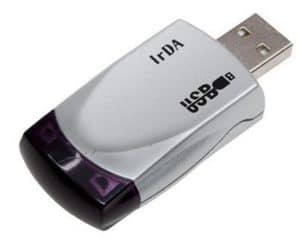IrDA, stands for Infrared Data Association, is an international consortium of hardware and software manufacturers that creates and promotes interoperable solutions for infrared (IR) data networking for computer networks, communication, and other networking applications.

The Infrared Data Association (IrDA), which was formed in 1993, has over 150 members from hardware, software, and communication sectors. It has developed and agreed on standard formats for communication between computers and infrared devices to ensure interoperability between different systems, platforms, and devices.
The IrDA also schedules meetings, conferences, and other events relating to infrared networking technologies. IrDA standards include the IrDA Data and IrDA Control infrared communication standards.
IrDA Control
IrDA Control is a standard developed in 1998 by the Infrared Data Association (IrDA) for communication over IR light between in-room cordless peripheral devices and a host computer. Peripherals such as keyboards, joysticks, mouse devices, and other pointing devices can use IrDA Control for communicating with their host computer.
IrDA Control is implemented using a suite of protocols that include the following:
- IrDA Control PHY (physical layer), which provides for data transmission that is bidirectional and error-correcting, over IR light at speeds of up to 75 Kbps over distances of up to 5 meters.
- IrDA Control MAC (media access control), which enables host devices to communicate with multiple IrDA Control peripherals and up to eight peripherals simultaneously. IrDA Control MAC offers a fast response time by using a polling interval of 13.8 meters and supports the dynamic assignment and reuse of addresses assigned to peripheral devices.
- IrDA Control LLC (logical link control), which ensures proper sequencing of data and handles retransmissions when errors occur.
IrDA Data
IrDA Data is a standard developed by the Infrared Data Association (IrDA) in 1994 for two-way point-to-point communication over IR light at speeds of up to 4 Mbps. IrDA Data is used for communication between palm computers, digital cameras, cellular phones, and other devices. It is implemented using a suite of protocols, including the ones listed.
- IrDA Data PHY (physical layer), which provides low-level continuous bidirectional error-correcting operation from 9600 bps up to 4 Mbps over distances of at least 1 meter. Specifically, asynchronous serial transmission is supported between 9600 bps and 115.2 Kbps, synchronous serial transmission at 1.152 Mbps, and synchronous communication at 4 Mbps.
- IrDA Data Infrared Link Access Protocol (IrLAP), a serial link protocol adapted by the IrDA for infrared serial communication from the High-level Data Link Control (HDLC) protocol. IrLAP provides a single serial connection between two IrDA devices and manages the device-to-device discovery, connection, and reliable data transfer functions.
- IrDA Data Infrared Link Management Protocol (IrLMP), which is used for link control and multiplexing of IrDA devices. IrLMP allows multiple IrDA devices to communicate over a single infrared link and provides for protocol and service discovery through the Information Access Service (IAS).
In addition to the three mandatory IrDA Data protocols described, a number of optional protocols are available that support flow control, port emulation, object exchange services, image exchange, interfacing with telephony devices, and infrared wireless access to local area networks (LANs).